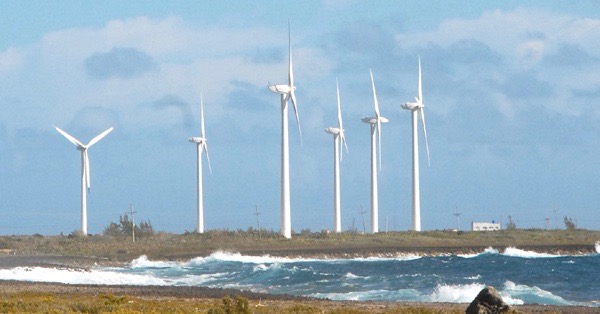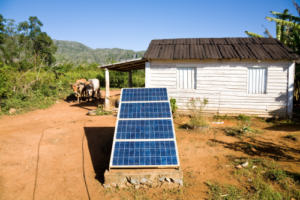
Growing electrical consumption puts pressure on the Cuban system
Home consumption of electricity continues to rise in Cuba, an unmistakable symptom of prosperity.
That statement, thus phrased, is inexact. Certainly, Cuban homes depend increasingly on the electric network, but that dependence is putting additional pressure on the national system of generation, which remains overly dependent on nonrenewable sources of energy.
In 1959, barely half the homes on the Cuban archipelago had access to electricity. The Revolutionary Government considered that service as an issue of public interest and raised the spread of domestic electrification to the current 99 percent.
Today, the public budget continues to cover much of the 21 cents that the State spends generating each kilowatt/hour of “current,” because the citizenry pays half a U.S. cent for each Kw/hr.
Mankind cannot conceive modern life without electricity even though, overall, it has used it for very little of its history. For that reason, Cubans were alarmed last July when unconfirmed reports circulated that predicted a return of the “blackouts” of the early 1990s, when the disappearance of the Soviet bloc left the nation without its habitual supplier of oil, the main fuel for the nation’s energy.
 After reporting that the total electricity consumption plan for 2016 would be 15,310 gigawatts (5,000 fewer than in 2015), the vice president of the Council of Ministers, Marino Murillo, stated in Parliament that the supply to homes would be protected, indicating that that’s the destination of 60 percent of the electric energy produced today in Cuba.
After reporting that the total electricity consumption plan for 2016 would be 15,310 gigawatts (5,000 fewer than in 2015), the vice president of the Council of Ministers, Marino Murillo, stated in Parliament that the supply to homes would be protected, indicating that that’s the destination of 60 percent of the electric energy produced today in Cuba.
That statement revealed a clear reality. A television set, a couple of fans, a refrigerator, a hot plate, an electric cooker, a washing machine and (with any luck) a computer, a microwave oven and an air conditioner add up to very little, compared with the gigantic electrodes of a steel factory, but when those elements are added up they make a difference.
The rise of Cuba’s domestic sector to the top of the structure of national power consumption was gradual, caused by several factors. In 2011, for the first time, it overtook the so-called residential sector, which includes state enterprises, joint ventures and other institutions, such as churches or cooperatives. That same year, it became necessary to allocated a minimum of 66,000 additional tons of oil to cope with the growing demand.
As Vice President Murillo pointed out, the proportion in favor of homes has continued to rise. It can be seen not only in the per-capita consumption but also in the rising number of families that every month consume between 200 Kw/hr and 500 Kw/hr, or more.
Many ‘smalls’ add up to a lot
The Cuban economy rose from the depths in the mid-1990s and the government placed energy savings among its priorities. Between 1995 and 1999, it spent $300 million reducing its oil purchases, exploiting its own oil fields and expanding the use of natural gas as domestic fuel.

In 2002, a German expert on the technology of energy savings, Dieter Seifried, recommended to Cuban authorities that they replace all refrigeration equipment that consumed power excessively. That, he said, would allow a rise in the nation’s energy efficiency. In 2004, the damage inflicted by a hurricane and the obsolescence of the thermal plants confirmed the accuracy of his prediction.
Cuba thus began its own Energy Revolution, at a pace (according to Seifried) much faster than European countries such as Germany, which did something similar in 2010.
In three years, thanks to credit breaks for the consumers, Cuba replaced 2.5 million refrigerators, 9 million incandescent light bulbs, 1.04 million fans, 230,000 television sets, 268,000 water pumps and 266,000 air conditioners.
Under the same benign conditions, Cuba obtained a variety of hot plates and cookers that took the place of the kerosene and gas stoves that — except for regions like Havana and Santiago de Cuba — were staples at most homes.
Economic links with China enabled the replacement of home appliances for a country like Cuba, subjected to an economic blockade by the United States. And because the purchase of such large quantities of new devices was so expensive, Cuba absorbed it by cutting back on the importation of crude oil, estimated at about 250,000 tons a year. The result was that, by 2007, three million Cuban homes depended on electricity to cook their food.

Cuba also built a network of small generating stations in all the provinces, began to renovate its distribution networks and set guidelines to expand the use of renewable-energy sources, such as solar and wind power and biomass.
Shortly thereafter, other experts warned that those measures would carry implications for the Cuban system of power generation. Two professors at the Las Villas Central University, Leonardo Casas Fernández and Alberto Ramírez González, indicated in 2007 that, while consumption dropped after the replacement of wasteful devices, the demand rose after the introduction of electric stoves and cookers. They pointed out that consumption rose at noon and in the afternoon, the times of massive food preparation.
About the answers
The policy of Energy Revolution did take into account the short-term rise of consumption in homes and is still trying to contain it. Although the State retained the subsidies, it went from a fixed rate to a progressive rate that charges more to consumers who use more electricity.
Halted in 2003, the sale of power-hungry appliances was resumed in 2011 and the rates for consumption above 300 Kw/hr were raised again. For that reason, families that consume much electricity now must pay 50 times more than minor consumers.
The Electric Union (UE) began to install digital electric usage meters and hardened its penalties against electric fraud. More recently, in 2014, 63,000 of those devices were replaced by infrared meters, mainly at the homes of self-employed entrepreneurs. However, on a national scale, the loss of energy continued.
The Cuban minister of Energy and Mines announced a plan to reduce to 17.7 U.S. cents the cost of energy production by means of cleaner technologies. He mentioned the projects to produce 750,000 Kw/hr with the bioenergy provided by sugar mills, for which pacts were signed with Russia and China.
Also in late 2014 a second phase of the Energy Revolution began with the renovation of lighting by the installation of LED lamps. Also by the retail sale of 2 million induction ovens 30 percent more efficient than those in use then.
In 2011, the director of the UE’s Rational Use of Energy project, Tatiana Amarán, said that the entity foresaw an increase in home consumption because of the sale of more home appliances and also by “an increase in economic activities made by self-employed entrepreneurs.” At the time, she told of studies to impose a differentiated rate to those users.
Five years later, the figures are proving her right, although the statistics continue to show that the production of electricity in Cuba depends on oil and that the percentage of renewable sources (much cheaper in the long range) remains low.
As if that weren’t enough, the analyses of meteorological centers forecast a rise in the minimal temperatures, which will further encourage additional expenses by the country as it deals with climate changes.
In 2013, the State began to sell liquefied gas without subsidies and by early 2015 official figures recorded more than 56,000 contracts to acquire it in five provinces. The announcement that such a service would not be the basis for Cuban cooking corroborates that the measure, along with previously mentioned steps, seeks to keep within acceptable numbers the consumption of electric energy in homes and to relieve the extra pressure caused by the growing number of self-employed entrepreneurs.
But, except for those general changes, no action has been taken to remove the representatives of the private sector from the gray zone in which they find themselves in the analyses of electrical consumption, because restaurants, rented homes, shops and other businesses launched by self-employed entrepreneurs ceased to qualify as simple dwellings and are not considered major industries.
That, and the dependence on electricity by most homes continue to seriously pressure the national system of generation and distribution.


